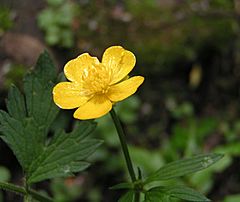Ranunculales facts for kids
Quick facts for kids Ranunculales |
|
|---|---|
 |
|
| Ranunculus repens | |
| Scientific classification | |
| Kingdom: | |
| Division: | |
| Class: | |
| Order: |
Ranunculales
|
| families | |
|
See text |
|
Ranunculales is a group, or order, of flowering plants. It includes the well-known Ranunculaceae family, which is also called the buttercup family. Plants in this order are among the earliest groups of flowering plants to have evolved. This means they have some features that are considered "older" in plant evolution.
Contents
What are Ranunculales?
Ranunculales is an important order within the larger group of dicots. Dicots are flowering plants that have two seed leaves, or cotyledons, when they first sprout. This order includes many different types of plants. They can be herbs, shrubs, or even vines.
Key Features of Ranunculales
Plants in the Ranunculales order share some common features. Their flowers often have many stamens and carpels. These are the parts of the flower that help with reproduction. The leaves can be arranged in different ways. They might be alternate or opposite on the stem.
Flower Structure
The flowers of Ranunculales plants can be quite varied. Some have very showy petals, like buttercups. Others might have smaller, less noticeable flowers. A common feature is that their flower parts are often arranged in a spiral. This is different from many other flowering plants where parts are in neat rings.
Leaf Types
The leaves in this order can also look very different. Some plants have simple, undivided leaves. Others have deeply lobed or compound leaves. This means the leaf is divided into several smaller leaflets.
Families in Ranunculales
The Ranunculales order includes several important plant families. Each family has its own unique characteristics.
Ranunculaceae (Buttercup Family)
The Ranunculaceae family is the largest and most famous in this order. It includes about 2,500 different species. You might know plants like buttercups, anemones, delphiniums, and clematis. Many of these plants are popular in gardens because of their beautiful flowers.
Common Ranunculaceae Plants
- Buttercups: These are bright yellow flowers often found in fields.
- Anemones: Also known as windflowers, they come in many colors.
- Delphiniums: Tall plants with spikes of blue, purple, or white flowers.
- Clematis: Climbing vines with large, showy flowers.
Papaveraceae (Poppy Family)
The Papaveraceae family is another well-known group within Ranunculales. This family includes the poppy and bleeding heart plants. They are known for their colorful flowers and often have a milky sap.
Poppy Characteristics
Poppies are famous for their delicate petals and often have a distinctive seed pod. They can be found growing wild in many parts of the world. Some poppies are grown for their seeds, which are used in food.
Other Families
Other families in the Ranunculales order include:
- Berberidaceae: This family includes plants like barberry and epimedium. Many are shrubs with thorny stems.
- Menispermaceae: This family mostly consists of woody vines found in tropical areas.
- Lardizabalaceae: Another family of woody vines, often with interesting fruit.
Where Ranunculales Plants Grow
Plants from the Ranunculales order can be found all over the world. They grow in many different habitats. You can find them in forests, meadows, mountains, and even deserts. Their ability to adapt to various environments shows how successful this plant group is.
Importance of Ranunculales
Many plants in the Ranunculales order are important to humans. Some are grown for their beauty in gardens. Others have been used in traditional medicine for a long time. However, it's important to know that some plants in this order can be poisonous if eaten.
Garden Plants
Many species from the Ranunculaceae and Papaveraceae families are popular ornamental plants. They add color and beauty to parks and gardens. Their diverse flower shapes and colors make them favorites among gardeners.
Medicinal Uses
Historically, some Ranunculales plants have been used for their medicinal properties. For example, certain species were used to treat pain or inflammation. It is very important to remember that these plants should only be used under expert guidance.
Life Cycle and Reproduction
Like all flowering plants, Ranunculales reproduce using seeds. Their flowers are designed to attract pollinators like bees and other insects. These pollinators help move pollen from one flower to another, leading to seed production.
Pollination
The bright colors and sometimes sweet scents of Ranunculales flowers help attract pollinators. Once pollinated, the flower develops seeds. These seeds are then dispersed by wind, water, or animals, allowing new plants to grow.
Seed Dispersal
Seeds from Ranunculales plants can travel in many ways. Some have structures that help them float on the wind. Others might have hooks that stick to animal fur. This helps the plants spread to new areas and grow.
See also
 In Spanish: Ranunculales para niños
In Spanish: Ranunculales para niños

